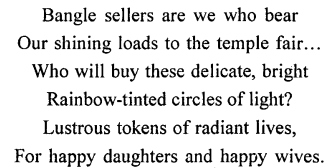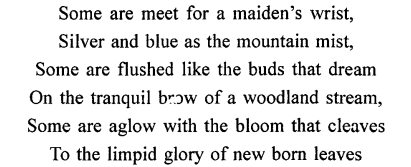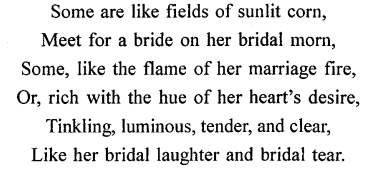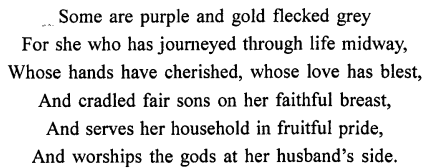Treasure Trove A Collection of ICSE Poems Workbook Answers Chapter 3 The Bangle Sellers- ICSE Class 10, 9 English
ICSE SolutionsSelina ICSE SolutionsML Aggarwal Solutions
EnglishMathsPhysicsChemistryBiology
Comprehension Passages
Stanza 1

Read the lines given above and answer the questions that follow.
Question 1.
Explain with reference to context.
Answer:
The lines given above are from the poem The Bangle sellers by Sarojini Naidu. This poem stands out as a social message that not only discusses the lives of Indian women but also the lives of bangle sellers. Although the poem focuses extensively on the stages in the life of women, it portrays the lives of the bangle sellers as well.
A bangle-seller talks about the various kinds of bangles he carries with him, and about the women that buy them. The poem describes the everyday life of bangle-sellers as well. The speaker of the poem is one such bangle seller and in the first two lines he describes what it is like to carry precious, ‘shiny loads’ of bangles to the temples, fairs and other such places where women can buy them. The third line is akin to a bangle seller’s cry for the sale of his bangles. He calls out to women who might buy these bangles. He thinks these bangles are the tokens of happy lives and happy marriages.
Question 2.
Who is the speaker in the poem?
Answer:
The Bangle Seller is the speaker in the poem. In the opening lines of the poem we see that it is Bangle Seller who says, “Bangle sellers are we who bear….. Our shining loads to the temple fair”. He describes himself and his bangles throughout the whole poem.
Question 3.
How are the bangles described in the first stanza of the poem?
Answer:
In the first stanza the bangles are described as lustrous, shining loads, rainbow-coloured, delicate and bright for happy daughters and happy wives.
Question 4.
What is referred to Rainbow-tinted circles of light ?
Answer:
The bangles are referred to as ‘Rainbow-tinted circles of light.
Question 5.
Explain the line’ lustrous tokens of radiant lives’.
Answer:
The bangle sellers invite people to buy their bangles by praising the qualities of the bangles. They say they are the shining gifts that promise happy lives in the future to the wearer of the bangles. He thinks these bangles are the tokens of happy lives and happy marriages.
Question 6.
What is the tone in this stanza? Quote.
Answer:
The tone is happy and joyful as evident by the line, ‘For happy daughters and happy wives
Stanza 2

Read the lines given above and answer the questions that follow.
Question 1.
Explain with reference to context.
Answer:
The lines given above are from the poem The Bangle sellers by Sarojini Naidu. This poem stands out as a social message that not only discusses the lives of Indian women but also the lives of bangle sellers. Although the poem focuses extensively on the stages in the life of women, it portrays the lives of the bangle sellers as well.
In stanza 2, the bangle-seller says that they carry different kinds of bangles, each catering to different types of women with different needs and preferences.
He says that some are blue and silver like the mist in the mountains, which are fit for a maiden’s wrist. Some bangles are of reddish hue like the flushed buds found along a stream. Some of the bangles glow like newborn leaves, owing to the dew and water from the stream. These are all representative of a young girl in her prime.
Question 2.
Explain ‘silver and blue as the mountain mist’
Answer:
This is an instance of a simile. Here, the color of the bangle is compared to the mist of the mountains. The bangle seller says that the blue and silver bangles are fit for the unmarried girls as they too are as pure and lovely as the mountain mist.
Question 3.
Mention the colours that are given or hinted at to describe the bangles.
Answer:
The colours are blue, silver, red and fresh green.
Question 4.
Pick out two simile from this stanza.
Answer:
The simile used here are
- Silver and blue as the mountain mist,
- Some are flushed like the buds that dream.
Question 5.
To what are the bangles compared?
Answer:
The bangles are compared to morning mist, flowering buds and new born leaves.
Question 6.
What stage of women’s life is referred to in this stanza?
Answer:
The stanza refers to the life of a young , unmarried girl.
Question 7.
Explain :
Some are aglow with the bloom that cleaves
To the limpid glory of new born leaves.
Answer:
Sarojini Naidu here compares the colours of the bangles to to the transparent glory of the new born leaves and flowers. The colours of the bangles are suitable for a unmarried girl, as they are as pure and fresh as new leaves.
Stanza 3

Read the lines given above and answer the questions that follow.
Question 1.
Explain with reference to context.
Answer:
The lines given above are from the poem The Bangle sellers by Sarojini Naidu. This poem stands out as a social message that not only discusses the lives of Indian women but also the lives of bangle sellers. Although the poem focuses extensively on the stages in the life of women, it portrays the lives of the bangle sellers as well.
Some bangles are of the colour yellow like sunlit com fields. They represent the happiness of a bride-to-be on the morn of her wedding. Then there are bangles which are flame coloured- red, orange; symbolic of a bride’s passion and desire, especially on her wedding night. These bangles are luminous and transparent, but also tender. The tinkling sound they make reminds one of the sound of a new bride’s laughter and the clear, tender finish of the bangles bespeak her tears as she leaves her childhood home for her husband’s.
Question 2.
The word ‘some’ has been repeated in the poem for a purpose. What is it?
Answer:
The word ‘some’ represents the different types of bangles in the poem.
Question 3.
Explain:
Some, like the flame of her marriage fire,
Or, rich with the hue of her heart’s desire,
Answer:
The red and orange bangles symbolise the brides passion and desire. They are luminous and transparent but also tender.
Question 4.
Pick a simile from the stanza.
Answer:
Some are like fields of sunlit corn,
Meet for a bride on her bridal morn,— This is a simile. Here the comparison is made between the yellow corn fields bathed in sunlight and the yellow coloured bangles.
Question 5.
Besides visual imagery the poet also uses auditory imagery.Pick out the lines.
Answer:
The lines are:
Tinkling, luminous, tender, and clear,
Like her bridal laughter and bridal tear.
The tinkling of the bangles is compared to a young bride’s laughter and the luminosity of the bangles is likened to her tears.
Question 6.
Mention the colours of the bangles in this stanza. What do they represent?
Answer:
The colours are yellow, red and orange representing the brides happiness and desire on her wedding day.
Question 7.
The poet has used several expressions which form pictures in the readers mind “fields of sunlit corn” and “circles of light”. Pick out more such expressions from the poem.
Answer:
Limpid glory and flame of her marriage fire are some expressions used in the poem
Stanza 4

Read the lines given above and answer the questions that follow.
Question 1.
Explain with reference to context.
Answer:
The lines given above are from the poem The Bangle sellers by Sarojini Naidu. This poem stands out as a social message that not only discusses the lives of Indian women but also the lives of bangle sellers. Although the poem focuses extensively on the stages in the life of women, it portrays the lives of the bangle sellers as well.
The last stanza focuses on the life of a woman after she’s married. The bangles for these women are purple with gold and grey flecks. They are representative of a woman who is of middle age or who has reached the mid-point of her life, where she has reaped the rewards of her strife. This is the age when she has already bore sons and is proud of her life as she supports her husband, be it in life or when worshiping the household gods.
Question 2.
What is the ryme scheme of the poem?
Answer:
The poem is made up of 4 stanzas, consisting of 6 lines each. Each stanza is divided into a quatrain and a couplet. The rhyme scheme the poem follows is aabbcc.
Question 3.
What do the purple and grey colours of bangles signify in this stanza?
Answer:
In the final stanza the poet talks about the pride of a woman who has lived girlhood and bridehood and motherhood, and earned a position as a matriarch. It is the phase in her life when her struggles have borne fruit. Therefore, this stanza has the air of royalty and pride etched in it. That is why the colours chosen to describe the bangles for a matriarch are purple and gold. The specks of grey add the touch of maturity that comes with age.
Question 4.
Explain:
And cradled fair sons on her faithful breast,
And serves her household in fruitful pride,
And worships the gods at her husband’s side.
Answer:
These lines are referring to the woman who has now seen life as a girl and bride and now is middle-aged. The imagery here shows that she has borne sons and nourished and cradled them close to her breast. It denotes that she has diligently performed her duties as a mother.
Question 5.
The patriarchal system is referred in this stanza. Quote.
Answer:
The mention of the patriarchy is done in the following lines:
- And cradled fair sons on her faithful breast,
- And worships the gods at her husband’s side.
Question 6.
What’kinds of bangles have earlier been mentioned?
Answer:
Bangles of different colours have been mentioned earlier: silver, blue, pink and green for virgin maidens, yellow and fiery red for the bride.
Question 7.
What hues of bangles are cherished by a bride ? What are they symbolic of?
Answer:
A bride cherishes yellow and fiery-red coloured bangles. These colours represent her happiness on the wedding day (yellow) and her passion on the wedding night (fiery red).
Question 8.
Purple and golden coloured bangles represent motherhood. How?
Answer:
Purple and golden coloured bangles represent motherhood. These colours are associated with the feelings of pride and fulfillment in the heart of the mother.
Question 9.
What fulfills the life of an Indian wife and mother?
Answer:
Rearing her sons, serving her family and sharing the proud place of being by the side of her husband at religious rituals fulfill the life of an Indian wife and mother.
Question 10.
What in the passage will repel a modern woman?
Answer:
A modem woman will be repelled by the patriarchal notions inherent in the passage: gender discrimination and insubordination of women In the social and religious set-up.
Project
Question 1.
Analyse the use of imagery in the poem ‘The Bangle sellers’.
Answer:
Naidu incorporates nature and the various hues of nature to represent her subject matter. She covers all kinds of colours to present emotions like hope, happiness, desire, love and pride. The after effect is a rainbow encompassing the different emotions felt by a woman in each passing phase of her life. Examples are as follows:
Some are flushed like the buds that dream
On the tranquil brow of a woodland stream,
Some are aglow with the bloom that cleaves
To the limpid glory of new born leaves –
This represents some of the bangles by comparing them to the transparent glory of the new bom leaves and flowers..
Then again she writes: ‘cradled fair sons on her breast’- the imagery here shows that she has borne sons and nourished and cradled them close to her breast. It denotes that she has diligently performed her duties as a mother.
Question 2.
How does Sarojini Naidu allude to the patriarchal system of her times? Discuss.
Answer:
Although it is only alluded to in innuendos, the patriarchal ideology lurks beneath the surface of the poem. The women are described as either happy ‘daughters’ or ‘wives’. Every phase she passes is referred to by a man in her life, father, husband, sons. The woman in this poem is fit into boxes that limit their existence to being a possessed object of patriarchy. Even if this poem is ironic, it still discusses the ideas propagated by the patriarchal society.
Question 3.
Pick out words and phrases which are examples of visual and auditory imagery in the poem.
Answer:
The poem consists of two types of imagery, they are a. Visual Imagery and b. Auditory Imagery.The Phrases; “shining loads”, “circles of light”, “silver and blue as the mountain mist”, “flushed like the buds that dream”, “Like fields of sunlit corn”, “like the flame of her marriage fire”, “Purple and gold-flecked” – all come under the Visual Imagery’. The Auditory Image which is used to indicate the sound of worn bangles is ‘tinkling’
Question 4.
Does the poem have feministic overtones?
Answer:
Yes, the poem give ample scope for feministic explanation. As in the final stanza the vital role assigned to women is explained with a tinge of irony.
Whose hands have cherished, whose love has blest,
And cradled fair sons on her faithful breast,
And serves her household in fruitful pride,
And worships the gods at her husband’s side
Question 5.
Pick out aparadox from the poem.
Answer:
The paradox ‘bridal laugh and bridal tear’ intensifies the attachment with the different colors of bangles to indicate the different moods and different phases in woman’s life.
Question 6.
Explain the use of figurative language in the poem.
Answer:
Many splendid metaphors are used to describe the colors of bangles. Rainbow-tinted circles of light, Tinkling, luminous, tender, and clear, Similes are also used; Some are flushed like the buds that dream, Some are like fields of sunlit com, Silver and blue as the mountain mist.maiden, bride and the woman who has journeyed the mid way of life; these words explain the important stages in a woman’s life and the importance the role of the bangles would play.
Question 7.
What are the five words used in the poem to describe the role of a middle-aged woman?
Answer:
The words are- blest, cherished, cradled, worships and serves
Question 8.
Comment on the feminine elements in Naidu’s poetry.
Answer:
The poetry of Naidu reflects feminine sensibility with regard to her choice of words, passion and imagery. Armando Menezes remarked rightly: She had a woman’s love of words. They are not, to her, just convenient instruments of expression, they were things: Precious, lovely things, like jewels. Sarojini Naidu was careful regarding the selection of words that lent grace to her poetry and helped her to convey her inner most feelings. We find in her poetry various aspects, relating to the use of words, which she employed to express her thoughts in charismatic tone.
Extra Questions
Question 1.
What-is meant by,’ rainbow tinted circles of light? What kind of literary figure is it?
Answer:
The phrase, ‘rainbow tinted circles of light’ refers to multi-coloured bangles which are in bright colours like the rainbow. The poet uses this metaphor for bangles and their diverse hues.
Question 2.
What are these bangles for? Why has the poet repeated the word happy in the last line here?
Answer:
The bangles are for maidens and wives. The poet has repeated the word happy as an oblique reference to the lives of these people who live a poverty stricken life and cannot be as happy as they appear to be. The bangles are happy tokens for happy lives
Question 3.
What colour bangles are preferred by virgin maidens?
Answer:
The virgin maidens prefer silver and blue bangles.
Question 4.
What rhyme scheme is followed in the poem?
Answer:
The rhyme scheme followed in the poem is aabbcc, which is a couplet for. It is mainly responsible for the melodious effect and fast rhythm.
Question 5.
Who is the narrator? What has been described earlier?
Answer:
The narrator is a bangle seller . Earlier the life of the bangle sellers is described obliquely. The poor bangles sellers work hard , going from fair to fair to sell their shining load of bangles but inspite of this they are happy . They barely earn enough to make ends meet.
Question 6.
In which context is the expression, ‘mountain mist’ used here?
Answer:
The expression, ‘mountain mist’ is used to describe the silver and blue coloured bangles for the virgin maiden who appears as innocent and delicately beautiful as the mist in the mountains.
Question 7.
Explain:
‘Some are aglow with the bloom that cleaves
To the limpid glory of new born leaves.’
Answer:
In these lines the poet describes the bangles which are shining green like the fresh and vivid green of the tender, new born leaves.
Question 8.
Why does the bride have preference for yellow coloured bangles for her wedding morning?
Answer:
The bride prefers yellow bangles which are like sunlit com fields because this colour represents her happiness on her wedding morning and her secret longings.
Question 9.
Why has the red colour of bangles been compared to the flame of the bride’s marriage fire?
Answer:
The red and orange bangles symbolise the brides passion and desire. They are luminous and transparent but also tender.
Question 10.
Which literary device is used in the last two lines:
Tinkling, luminous, tender, and clear,
Like her bridal laughter and bridal tear.
Answer:
The poet has used simile by comparing using the word like. He also uses paradox when he refers to the brides happiness on getting married( laughter) and sadness(tear) at being separated from her parents.
Question 11.
Why does the poet refer simultaneously to bridal laughter and bridal tear?
Answer:
The poet refers simultaneously to bridal laughter and bridal tear to bring to the forefront the dilemma faced by all brides when on one hand is the joy of marriage and on the other side the sorrow of leaving their parents. The poet highlights this paradox.
For More Resources
